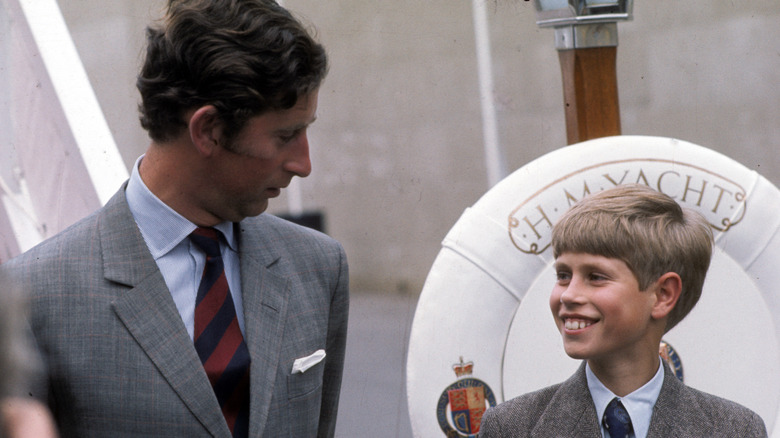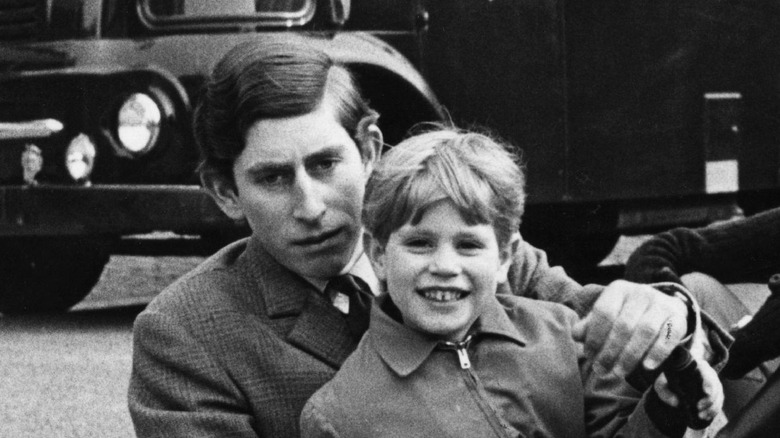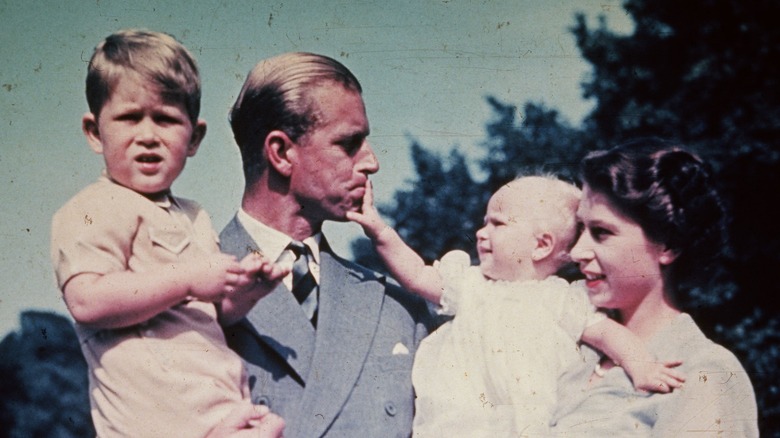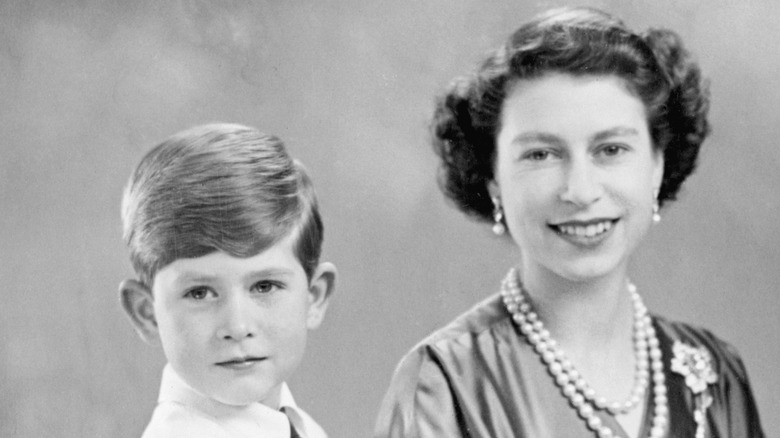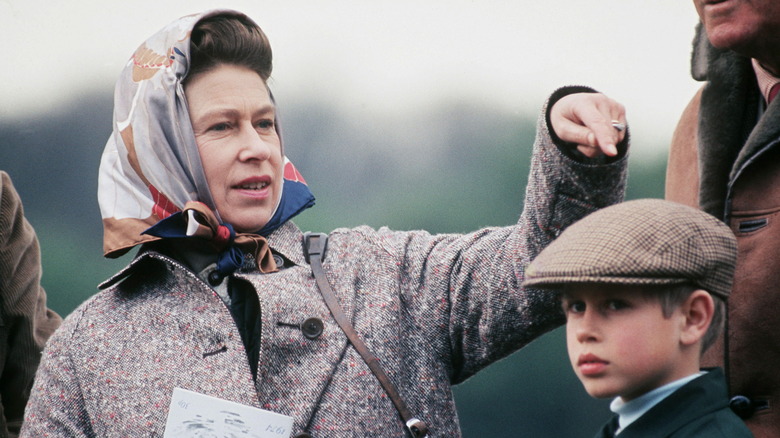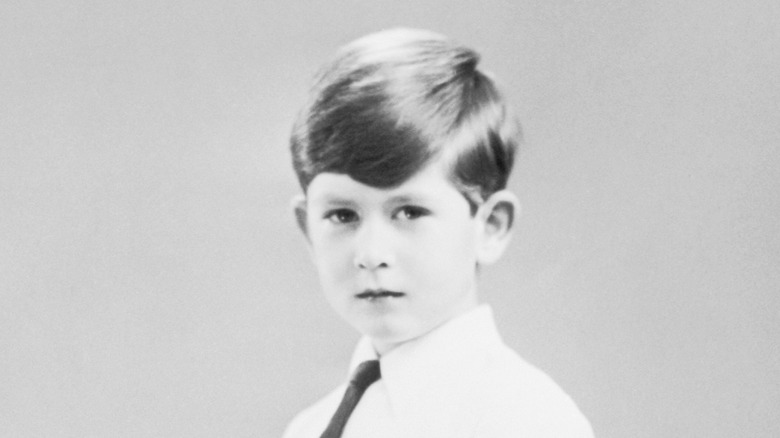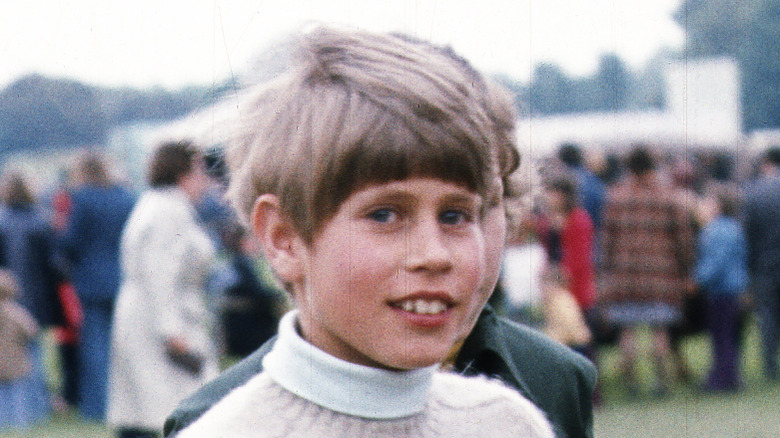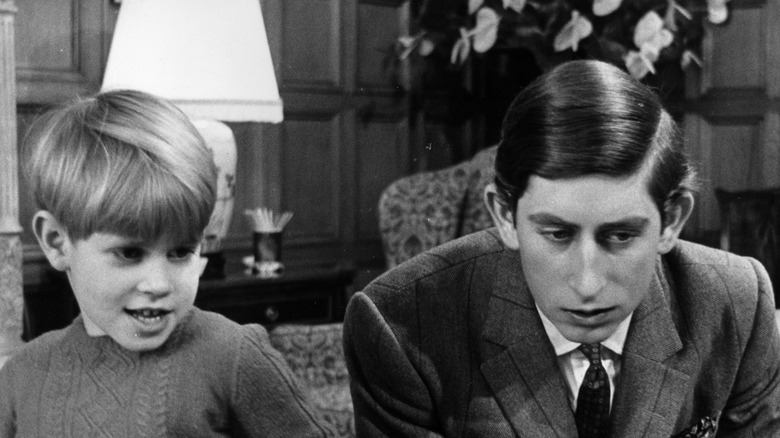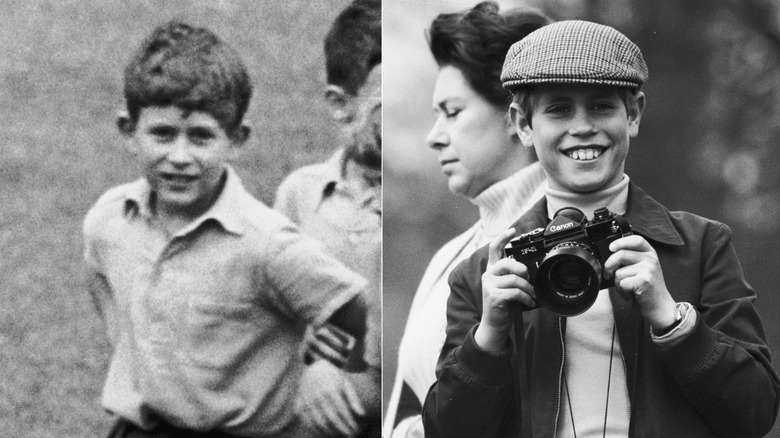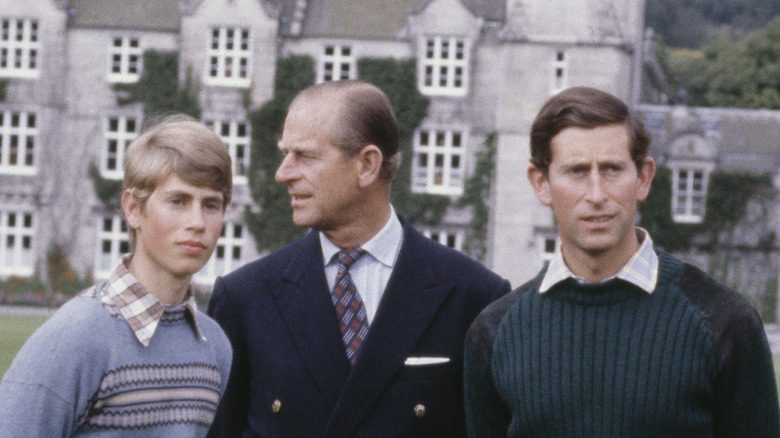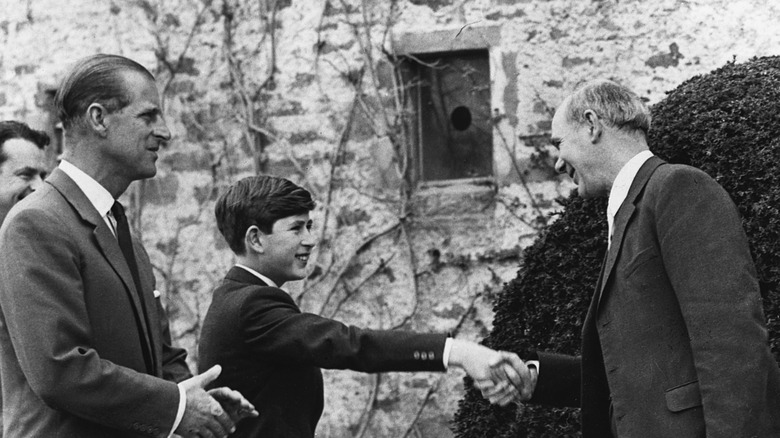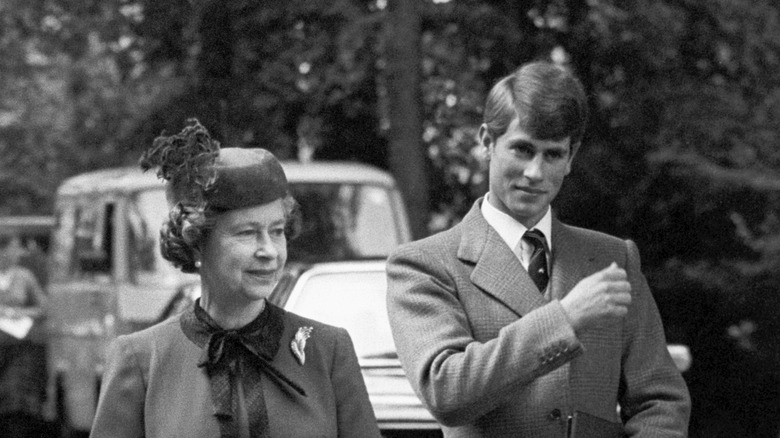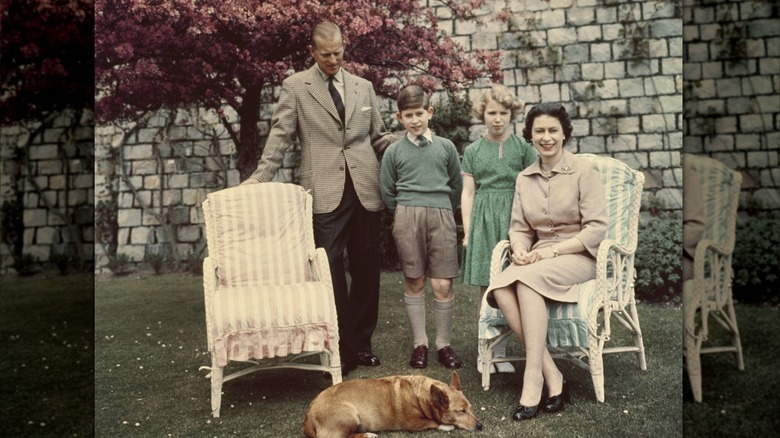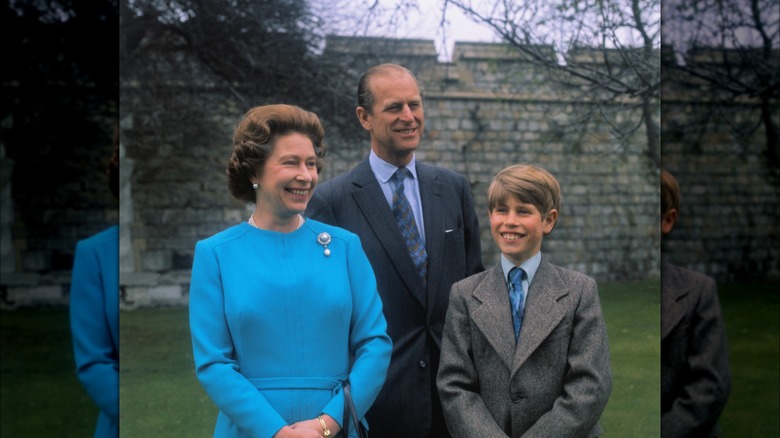The Big Differences In King Charles And Prince Edward's Childhoods
Royal childhoods are no copy-and-paste experience — a fact made obvious by the major differences in how King Charles III and his youngest brother, Prince Edward, grew up. But how different can the children of the late Queen Elizabeth II and Prince Philip really be, you may ask? They had the same parents, were born at this little-known place known as Buckingham Palace, and experienced a lifestyle just as comfortable as the lavish royal children today. Additionally, they shared the same siblings, attended public events, and had access to world class education — all while having to follow the same insane rules for royal children.
However, you may be surprised to learn that these royals aren't so similar. By comparing the upbringings of these two royals, we can better understand the circumstances that shaped them as individuals on their own distinct paths, as well as how the stark differences in their childhoods may continue to impact the relationship between King Charles III and Prince Edward today.
The royal brothers are 16 years apart
One of the most glaring differences between the childhood experiences of King Charles III and Prince Edward is the significant age gap between them. In the sixteen years between King Charles III's birth and the birth of his baby brother, Prince Edward, the UK experienced major events — from the change of power between four prime ministers to the shifting status of the monarchy on an uncertain global stage.
Born at Buckingham Palace in November 1948, King Charles III was already making waves as the first Windsor of the next generation as well as the first of Queen Elizabeth II and Prince Philip's four children. When Queen Elizabeth II had Prince Edward in March 1964, she and Prince Philip had gained sixteen years of experience as parents. With three older siblings to look up to and measure himself against, Prince Edward found himself in the opposite end of the spectrum than King Charles III, and was able to follow the footsteps of those who went before him. Unlike his youngest brother, King Charles III had to wait two years until Princess Anne's birth in August 1950 for a sibling to play with and relate to. And though he surely gained playmates in siblings Princess Anne, Prince Andrew, and Prince Edward, King Charles III also surely gained an additional weight on his shoulders as the oldest sibling. Prince Edward, however, could look up to his siblings — and continues to do so.
King Charles III was born before Queen Elizabeth II's coronation
Only 22 years old when she had her first son, Queen Elizabeth II was able to spend more time with a young King Charles III as she and Prince Philip moved their new family into their first home together. For those three precious years, King Charles III got to experience his mother not as the reigning monarch, but as his mother — something Prince Edward would never be able to experience. King Charles III remembers playing in the gardens and how his mum loved filming him. Even if this more carefree period of his life was not meant to last, King Charles III speaks of it still today with great fondness.
Everything changed, however, when Prince George VI died and Queen Elizabeth II ascended the throne at 25 years old. Three years after her oldest son's birth, Queen Elizabeth II became the sovereign and King Charles III began his reign as the longest-serving heir apparent to the throne. In an interview featured in the BBC documentary "Charles R: The Making Of A Monarch," King Charles III reflected on his mother's coronation. "I remember my mama coming out where we would be in the bath as children wearing the crown," he said. "[The crown] was incredibly heavy — that's why mama had to practice so much wearing it."
Queen Elizabeth II was absent for much of King Charles III's childhood
When Queen Elizabeth II ascended the throne, state duties took priority and King Charles III would unfortunately be separated from his mother. In an interview featured in the BBC's "Charles R: The Making of a Monarch," King Charles III shared, "I remember when I was quite young trying to talk on the telephone when she was miles away." In addition to his inability to reach his mum, the lack of physical affection surely added to the young prince's sense of loneliness. For example, when Queen Elizabeth II and Prince Philip returned from a six-month tour of the Commonwealth, King Charles III and his sister Princess Anne were greeted with formal handshakes.
However, reports even suggest that Queen Elizabeth II was absent from her son's life even before duty got in the way. She did not witness her eldest's first steps. Charles spent his first Christmas without his parents — who instead chose to spend the holiday in Malta where Prince Philip was serving in the Navy. The young royal's first word was "nana" in reference to Mabel Anderson, his nanny. What's more, the first words of the future king were not witnessed by his parents, but were instead only documented by the staff employed to take care of him.
Prince Edward was able to spend more time with their mother
By the time Prince Edward came along in 1964, Queen Elizabeth II was well into her historic reign and was able to spend more time with her youngest child. Having gathered 13 years of experience as the queen, it's fair to say that she also had grown in her understanding of what it meant to be a mother — and was able to spend more quality time with her youngest boys, Prince Edward and Prince Andrew.
As royal expert Dr. Owens told Express, the growing size of the royal family freed some of Queen Elizabeth II's time and gave her the freedom to take breaks from royal duties in order to be with her young boys. Dr. Owens mentioned how ceremonies celebrating colonial independence became just one example of an international engagement that could be fulfilled by another member of the royal family and lessen the burden on the queen. When King Charles III was young, much of the responsibility of duty fell on the shoulders of Queen Elizabeth II and Prince Philip. However, Queen Elizabeth II was slowly able to rely on other members of her family such as King Charles III and Princess Anne. "This gave Elizabeth II more time to spend with her younger sons and she adopted a more hands-on approach to raising the boys," Dr. Owen explained.
King Charles III's had an intimidating path before him
King Charles III was born and raised to be the future king of England — something that his youngest brother, Prince Edward, did not experience. Practically from the very moment he entered the world, King Charles III was in the spotlight. In fact, he was quite literally put on display as an infant for the royal courtiers in the ballroom of Buckingham Palace. As King Charles III grew and continued to prepare to one day become king, he also became subject to all of the expectation and pressure that accompanied his role as heir apparent in the process.
With centuries of precedent for how a future monarch should be raised, King Charles III undoubtedly felt trapped. In an interview featured in "Charles R: The Making of a Monarch," a 21-year old King Charles III reflected on the moment he realized that he was "no ordinary chap," saying, "It's something that dawns on you in the most ghastly and inexorable way." He continues by describing the heavy weight of knowing that people are interested in you and watching your every move. And even though Prince Edward was also raised in the spotlight, the pressure of being born third-in-line to the throne is not as great as the weight of being the heir apparent — a role that King Charles III never seemed to fully embrace.
Prince Edward has always had more freedom
With his oldest brother away at school and speculation already growing as to who he would marry, Prince Edward's likelihood of ever inheriting the throne was small from the start. Therefore, Prince Edward had more freedom (and more options) when it came to deciding what he wanted to do with his future.
At 2 years old, Prince Edward learned to ride a Shetland pony. By age 5, he had decided to become an astronaut — a goal he expressed to the first man ever to walk on the moon, Neil Armstrong. Unlike his brother, Prince Edward's future was not set in stone, and so he had the flexibility to dream of future possibilities. Eventually, the youngest prince decided to pursue a career in the entertainment industry before becoming a working royal — a career that he was able to choose for himself unlike his brother.
The royal siblings attended different schools
When looking at how far royals went in their education, King Charles III and Prince Edward are rather similar on paper: they both started their schooling at Buckingham Palace with a governess, eventually moved onto local programs, attended the famed Gordonstoun school, and ended up at Cambridge. However, there were some twists and turns along the way.
As a child, King Charles III already displayed the shyness that would come to characterize his young development. Prince Edward, however, is said to have enjoyed his independence at the time — something that King Charles III struggled with. When each prince turned 8, they began their formal schooling. King Charles III made history as the first heir apparent to attend school when his parents enrolled him in London's Hill House School so he could be in a more social setting. However, his experience at Hill House School wasn't particularly warm as he had difficulty fitting in. (It probably didn't help that King Charles III arrived in a limousine.) Even after he transferred to Cheam School, where he stayed for five years, King Charles III reportedly also had a difficult time fitting in.
Prince Edward's educational path diverted from his brother's when he became a student at Gibbs School in Kensington — without the entrance of a royal limousine. After Gibbs, the young prince joined his brother Prince Andrew at Heatherdown Preparatory School in Berkshire.
Their childhood interests differed from each other
Ever since each of the royal brothers were young, King Charles III and Prince Edward displayed their own distinct interests. King Charles III specifically wasted no time in revealing his aptitude for the arts. He gravitated toward painting and drawing, enjoyed reading and writing, and learned to play both the piano and the trumpet. Eventually, he chose to continue with his instrument of choice: the cello – which he would play in his dorm room whenever he had free time. As he continued in school, King Charles III also discovered a passion for the theatre. Falling in love with Shakespeare in particular, King Charles III adored the stage. Mathematics and physical sports on the other hand? A hard pass for the future king.
On the other side of the spectrum is his youngest brother, Prince Edward, who showed more of an inclination for physical activities. He participated in team sports such as rugby and polo, and even spent six months in New Zealand as a horse tutor. Within the classroom, Prince Edward seemed to take a particular interest in history — a subject that he would eventually study at Jesus College in Cambridge.
They varied in their school performances
Before King Charles III made history by becoming the first royal to obtain a degree from university in 1970, he had to study for and complete his exams — just like his brother. During his secondary education at Gordonstoun in Scotland, King Charles III passed and received certification in five of his O-level courses in History, Latin, French, English Language, and English Literature. He was shown up, however, by his younger brother Prince Edward who achieved an impressive nine O-levels.
But don't take the royal brothers' O-level performances to prove that Prince Edward was the better student. In fact, when it came to the A-levels, Prince Edward's academic success took a turn for the worst: a C and two Ds in English, History, and Politics respectively. Despite these less-than-impressive grades, the youngest son of Queen Elizabeth II was accepted into Jesus College at Cambridge. King Charles III, on the other hand, did only slightly better than Prince Edward by receiving a B in History and C in French. He, too, went on to study at Cambridge.
King Charles III had a difficult experience at Gordonstoun
When he was 13 years old, King Charles III followed in Prince Philip's footsteps by enrolling in Gordonstoun. However, where Prince Philip excelled in Gordonstoun's culture of hard work and grit, King Charles III struggled in every sense of the word and was heavily bullied. In a letter written during his time at Gordonstoun, King Charles III revealed that he could barely sleep because other students would hit him with slippers and pillows throughout the night — one of many tragic details in King Charles III's life. This cruel treatment was confirmed by King Charles III's former classmate Johnny Stonborough, who recalled the intense bullying of the "outsider" royal during their school days together. He told "CBS Mornings," "Nobody wanted to be his friend because if you were his friend, then you were teased brutally for being his friend."
Despite reports that he was physically targeted by other students during rugby matches, and had his ears pulled, the young royal never complained. In fact, in the years since this difficult experience, King Charles III has spoken highly of his time at the school. As he once told The Observer (via BBC), "Gordonstoun developed my willpower and self control, helped me to discipline myself... We went in for adventure." One positive aspect of his experience is that he discovered a passion for pottery, theatre, and archaeology.
Prince Edward, on the other hand, seemed to excel
Like his father and brothers before him, Prince Edward moved to the 200-acre campus of Gordonstoun in pursuit of its physical, mental, and academic rigor. Unlike his brother King Charles III, however, Prince Edward seemed to do well at the school — no doubt earning the respect and admiration of Prince Philip, who embraced the competition of the unconventional boarding school as a student. While at Gordonstoun, a Prince Edward became involved in extracurriculars and even became head boy, or "guardian" as it is known at Gordonstoun.
Additionally, he seemed to be more popular than his oldest brother — although he was apparently bullied by Prince Andrew, who also attended Gordonstoun at the time. Regardless of the teasing of an older brother, Prince Edward excelled. In 1986, Prince Edward made his family proud when he was even given the Duke of Edinburgh's Gold Medal by his own father for which the honor is named. In the years since attending his former school, Prince Edward has maintained a relationship with the institution and even traveled to Scotland in 2022 in order to present awards to the Moray community.
Prince Philip was very hard on his oldest son
Early on in King Charles III's childhood, it was apparent that he was very different from his strong-willed and rough-edged father, Prince Philip. Soft-spoken and sensitive, King Charles III's gentler disposition drew his father's concern. Believing that his son needed to be toughened up, Prince Philip would bluntly criticize King Charles III and cause the heir apparent to withdraw further within himself — becoming even more vulnerable in the eyes of his father.
Prince Philip's insistence that King Charles III attend his own beloved alma mater of Gordonstoun did not help bring them closer, but actually emphasized the foundational differences between them. Where Prince Philip excelled in sports, King Charles III fell in love with the theatre — an endeavor that did not seem to please his father. According to The Telegraph, Charles once told reporters that he could hear Philip laughing during a school production of a Shakespeare play — and no, it wasn't a comedy. Although King Charles III was obviously bursting with feelings that needed expressing, his father was not receptive to them. Failing to live up to the great expectations that were assigned to him by Prince Philip (and the historical monarchy he was born to), King Charles III was equally lonely at home as he was at school.
Prince Edward seemed to have a different relationship with their father
While Prince Philip was reportedly playing squash when King Charles III was born, he was present for Prince Edward's birth in 1964. This was the first and only time Philip was with Queen Elizabeth II while she gave birth. Elizabeth asked that Philip be there for the arrival of their youngest child, a request that broke royal tradition: Philip became the first royal father in recent history to be by his wife's side while she gave birth to Edward.
From that moment on, Philip appeared to be a present and positive figure in Edward's life. In an interview with ITV News, Prince Edward remembers his father as "someone who was always there, who was always encouraging, and [who was] actually never pushing." Prince Edward surely won the favor of his father through his affinity for sports and physical activity — an area that King Charles III never embraced.
When Prince Philip died in April 2021, it was Prince Edward who inherited his father's title as the Duke Of Edinburgh. He continues his father's legacy today through his involvement with the Duke of Edinburgh's Award, of which he became the patron in 2023. Though Prince Philip's relationship with his youngest son was different than the one he had with King Charles III, both royals have irregardless forged their own unique paths and learned from their own experiences in order to move forward with their own families.
